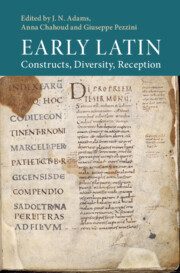Book contents
- Early Latin
- Early Latin
- Copyright page
- Dedication
- Contents
- Illustrations
- Tables
- Contributors
- Acknowledgements
- Abbreviations
- Chapter 1 Introduction: What Is ‘Early Latin’?
- Part I The Epigraphic Material
- Chapter 2 Alphabet, Epigraphy and Literacy in Central Italy in the 7th to 5th Centuries bc
- Chapter 3 Identifying Latin in Early Inscriptions
- Chapter 4 The Egadi Rostra
- Part II Drama
- Part III Other Genres and Fragmentary Authors
- Part IV Reception
- Bibliography
- Index Verborum
- Index of Non-Latin Words
- Index Locorum Potiorum
- Subject Index
Chapter 2 - Alphabet, Epigraphy and Literacy in Central Italy in the 7th to 5th Centuries bc
from Part I - The Epigraphic Material
Published online by Cambridge University Press: 27 July 2023
- Early Latin
- Early Latin
- Copyright page
- Dedication
- Contents
- Illustrations
- Tables
- Contributors
- Acknowledgements
- Abbreviations
- Chapter 1 Introduction: What Is ‘Early Latin’?
- Part I The Epigraphic Material
- Chapter 2 Alphabet, Epigraphy and Literacy in Central Italy in the 7th to 5th Centuries bc
- Chapter 3 Identifying Latin in Early Inscriptions
- Chapter 4 The Egadi Rostra
- Part II Drama
- Part III Other Genres and Fragmentary Authors
- Part IV Reception
- Bibliography
- Index Verborum
- Index of Non-Latin Words
- Index Locorum Potiorum
- Subject Index
Summary
This paper discusses the origins and the transmission of the alphabet to the peoples inhabiting the lower and central Tiber river valley. While some consideration is given to the development of the alphabet of Etruscans, as the driving force behind the dissemination of writing and literacy in central Italy, and to the alphabet(s) of Sabellic speakers, the focus is squarely on Latin and its sister language/dialect Faliscan. The paper aims to flesh out alphabetic reforms, signal possible areal developments, and identify major regional/chronological developments in the period before movements toward more standard orthography and letterforms in the two writing systems. The paper also maps out the diversity of epigraphic forms and their functions, which, it turns out, are much less homogenous in Latin and Faliscan than is the case in Etruscan during this same time period. Ultimately, the investigation reveals a vital epigraphic cultures in Latium and in Falerii that were adapting to the changes in social, political, and economic realities of the period, and that were, as a result, beginning to forge their own regional identities.
Keywords
- Type
- Chapter
- Information
- Early LatinConstructs, Diversity, Reception, pp. 15 - 40Publisher: Cambridge University PressPrint publication year: 2023

